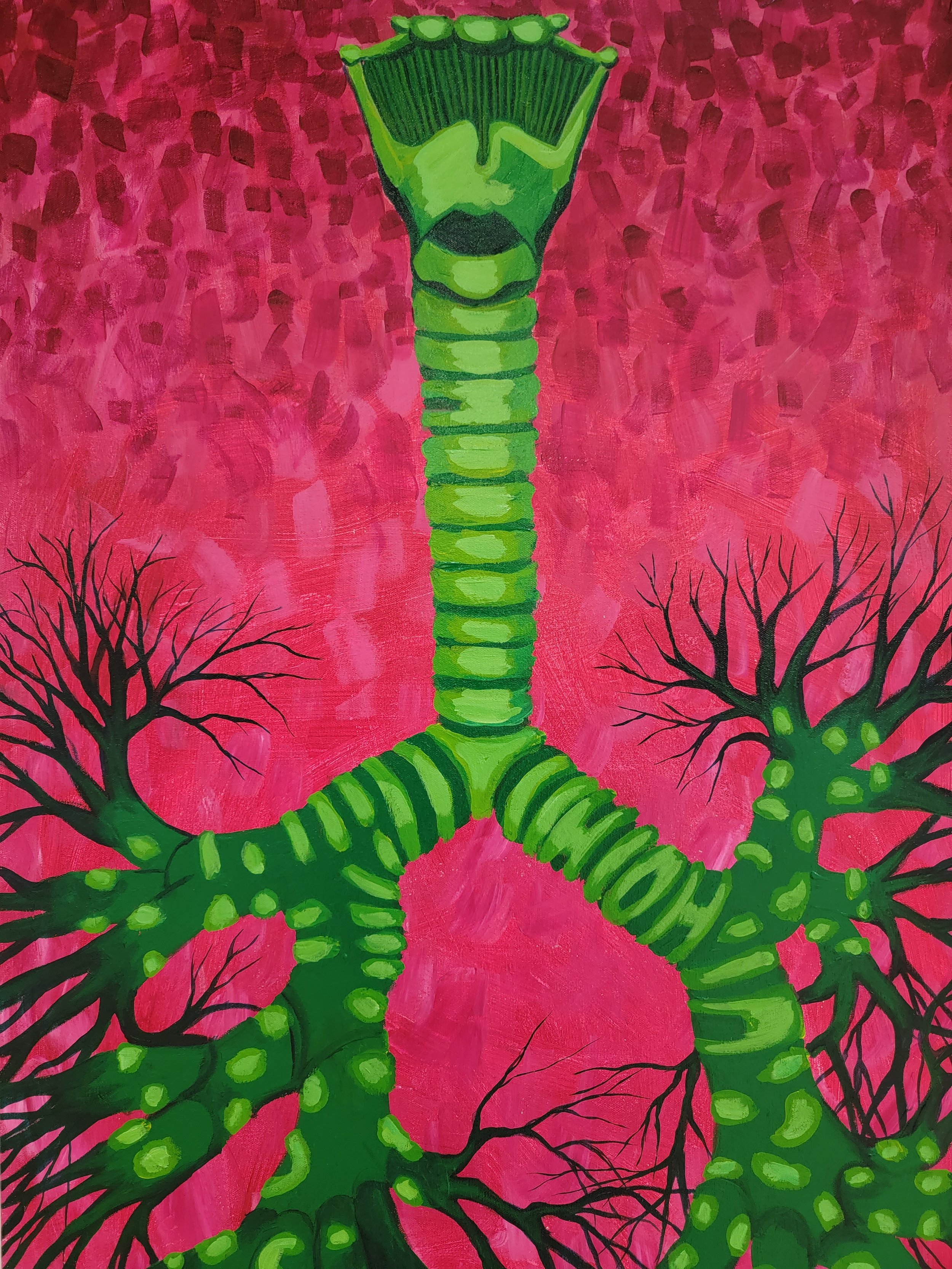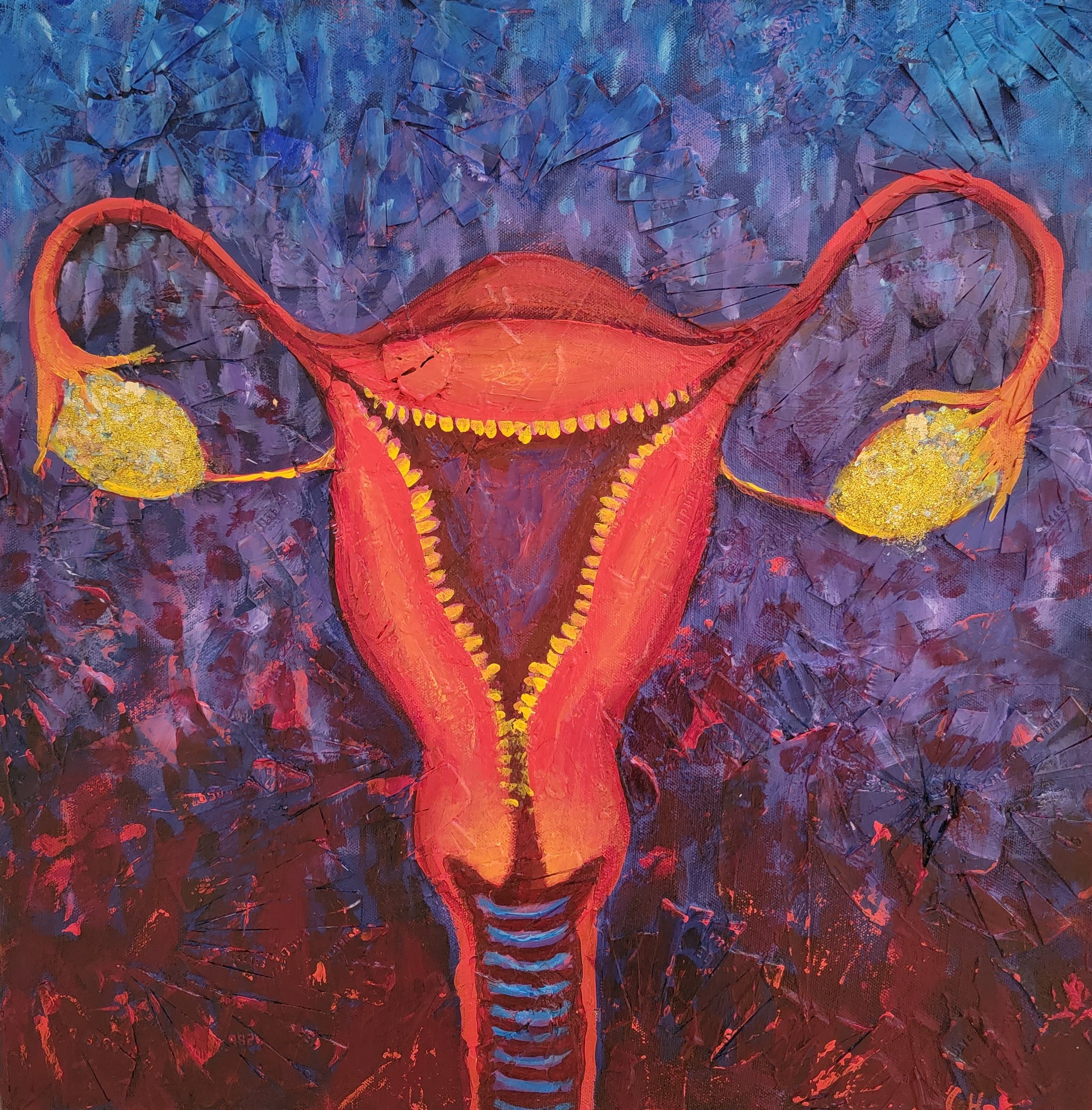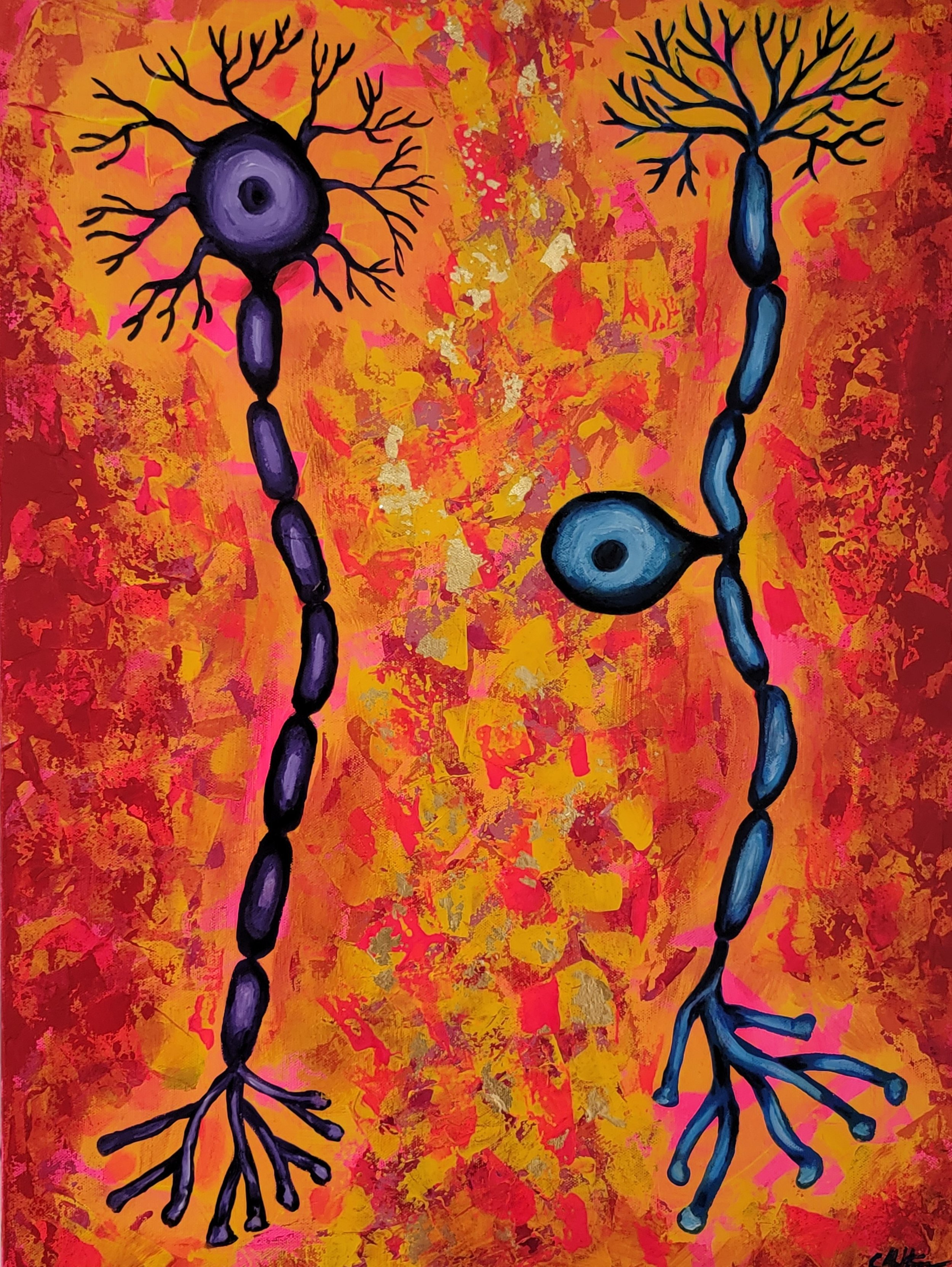Artist Statement
My paintings and drawings explore the symbology, purpose, and functions of living things. They are portraits meant to celebrate and venerate living systems for their beauty, unique traits, characteristics, ancient designs, and meaning. I am interested in branch-like forms, patterns, and symmetry found in the human anatomy, symbols of nature such as the tree, and animals. I’m fascinated by and in awe of these living systems, their functions and their energies, my own human organs included.
I celebrate my subjects using bright colors to bring attention to them and to add fantasy. Lively, painterly brushstrokes exaggerate their movement and vitality, while up-close views, intentional compositions, and abstracted or fantasy-like environments help viewers to find enchantment and draw their attention to the beauty of the living object itself.
The pelvis provides support for both the spinal column and the soft organs. It represents stability and strength in the body and creates a solid core through which I can sit and connect to the ground in meditation.
The Anatomy of Breath, 10”x10” 2021
Unhurt, 36”x36”, 2021
The Regulator (Thyroid) 10”x10”, 2021
Kidney 10”x10” 2021
The Light (for Dalia) 24:x24” 2020
Love Machine, 2021
Filter (to my Liver) 2021
Lymph Node Dragonflies 2021
The Spirit Tree, 24”x36” 2020
Thyroid Baptism, 12”x16” 2021
Expanse, 11”x14” 2021
Alert, Awake and Alive, 18”x24” 2020
The Sound of Silence, 2021
The cochlea is the auditory area of the inner ear that changes sound waves into nerve signals. Here the subject is celebrated for its physical form, a quality of this organ which is not universally recognized. The cochlea, with its delicate canals and forms, is featured floating over a deep and vast landscape.
Perception, 2021
The eye is a sensory organ, collecting light from the visible world around us and converting it into nerve impulses. The optic nerve transmits these signals to the brain, which forms an image thereby providing sight.
This diagram shows details of a human eye, and also hints at an aerial view of an imagined place
Translation (Listening) 2021
The human ear is an organ of auditory perception and equilibrium that detects and analyzes sound by transduction, the conversion of sound waves into electrochemical impulses, and maintains the sense of balance. The folds of the outer ear are delicate and intricate, and can resemble the shapes of seashells or flower petals. This is the artist's ear, illustrated in golden hues and textured brushstrokes, a visual representation of listening in conversation, a struggle to communicate and the vibrations received through the ear canal.
Larynx 2021
The larynx, also commonly called the voice box or glottis, is the passageway for air between the pharynx above and the trachea below. The larynx plays an essential role in human verbal communication; during sound production, the vocal cords close together and vibrate as air expelled from the lungs passes between them. This physical organ is given a lustrous glow for reverence at how magical it can feel to make sounds.
Lymph Dance 2021
Lymph nodes filter substances that travel through the lymphatic fluid, and they contain lymphocytes (white blood cells) that help the body fight infection and disease. This bright, healthy and sinuous formation floats over a colorful background of blues, inspiring the sea or sky.
Staying the Course 2021
The liver is essential for digesting food and ridding your body of toxic substances. The stomach secretes acid and enzymes that digest food.The purpose of the large intestine is to absorb water and salts from the material that has not been digested as food, and get rid of any waste products left over. By the time food mixed with digestive juices reaches your large intestine, most digestion and absorption has already taken place.This short section is the part of the small intestine that takes in semi-digested food from your stomach through the pylorus, and continues the digestion process. The duodenum also uses bile from your gallbladder, liver, and pancreas to help digest food. The butterfly in the stomach is a visual reference to the cliché "butterflies in the stomach" referring to anxiety or nervousness. Highlighting this feeling contrasts with the involuntary function of a healthy digestive system.
Dissection (Anatomy of a Lymph Node)
Lymphadenectomy is a surgical procedure in which the lymph nodes are dissected and a sample of tissue is checked for the presence of malignancy under the microscope. It is an operation usually performed as part of the surgical management of malignant tumors. The anatomy of a lymph node is mysterious and not commonly known, though only through a pathology exploration are these secrets revealed. Losing loved ones due to lymphoma created a personal inquiry and exploration into the function, anatomy and treatment of lymphatic cancer. This illustration is a depiction of a healthy lymph node.
The Width of My Love, 2021
The pelvis plays important functions in locomotion, as body weight is transmitted to the lower limbs through the pelvic girdle, childbirth, as the human neonate must pass through the birth canal, which lies within the pelvic girdle as the baby exits the body, and support of abdominal organs which are held up by both the pelvic floor musculature and the pelvis itself. Viewing the width and depth of hips and belly as a burden, the desire to become smaller and take up less physical space is familiar in American culture. Here the pelvis is fully acclaimed with bright pink hues and on a large 4’x4’ scale.
Tracheobronchial Tree 2021
The lower respiratory tract is called the tracheobronchial tree, describing the branching structure of airways supplying air to the lungs. It includes the trachea, bronchi and bronchioles. At each division point or generation, one airway branches into two or smaller airways. These branching forms, so much like the venation of tree limbs or leaf veins, also distribute material more efficiently from one location to another.
Voicebox 36”x36” 2021
The larynx, or voice box, is located in the neck and is involved in swallowing, breathing, and voice production. Sound is produced when the air which passes through the vocal cords causes them to vibrate and create sound waves in the pharynx, nose and mouth. The view illustrated here is a vertical perspective, as if looking down the throat from up above the head. The form is both familiar and illusive, suggesting other anatomy in the human body.
Legacy (Uterus, Ovaries and Fallopian Tubes) Mixed media, currency and credit cards on canvas
The question of what we leave behind can be especially fraught for people who do not have children. In this piece, materials of personal financial wealth are used to fashion female reproductive organs, generally considered the most commonly named, enduring way to leave a legacy. There are existential implications of not having offspring, which can drive the search for meaning and lasting impact in a life, while financial endowments and the passing of heirlooms can for some supplant this.
Neuron Dance
These neurons are the cells responsible for receiving sensory input from the external world; for sending motor commands to our muscles, and for transforming and relaying the electrical signals at every step in between. Such connections between sensory and motor neurons underlie motor reflex loops and several forms of involuntary behavior, including pain avoidance. The neuron on the left is a motor neuron whose cell body is located in the motor cortex, brainstem or the spinal cord, and whose axon (fiber) projects to the spinal cord or outside of the spinal cord to directly or indirectly control effector organs, mainly muscles and glands. The sensory neuron (on the right) are neurons in the nervous system that convert a specific type of stimulus, via their receptors, into actions or impulses.























